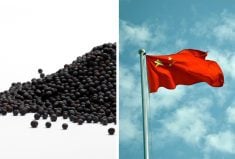By Theopolis Waters
CHICAGO, April 23 (Reuters) – Porkier pigs are commanding premiums in the United States as packers and producers look for ways to mitigate the effects of a smaller herd caused by a lethal virus by pushing weights up to record highs, but leaner times may be ahead.
Plumper hogs are helping to offset a drop of around 10 percent in the national herd as piglets die from Porcine Epidemic Diarrhea virus (PEDv) and putting more money in the pockets of those producers with pigs to sell.
Read Also

Canada, Mexico look beyond U.S. as agri-food trade pact expands
Earlier this week Heath MacDonald, Canada’s Minister of Agriculture and Agri-Food and Mexico’s Secretary of Agriculture and Rural Development, Julio Berdegué, met to discuss bilateral relations and strengthen cooperation and trade ties between the two countries.
John Ginzel, an analyst with Chicago-based brokerage firm Linn Group, said weight was being pushed “to the outside of the envelope compared to what we’ve ever seen.”
“They’re elephants,” Ginzel said.
Latest figures on Wednesday put average hogs at 286.4 pounds, the fifth record in a row and up 9.3 lb. from a year ago. That adds up to about 15 million lb. of extra pork on the market for the week, said Bob Brown, an independent market analyst in Edmond, Oklahoma.
PEDv has swept through 30 states and some analysts estimate it has killed up to seven million pigs out of a total herd of 62.899 million. More information on the virus’ stretch may emerge now that the United States Department of Agriculture is mandating reporting of outbreaks.
While many farmers used to be penalized for overweight pigs, some processors will now pay extra for record hogs to make up for lost numbers. Increased weight alone added the equivalent of 67,000 hogs in last week’s slaughter from a year ago.
Hog prices have risen nearly 27 percent since PEDv first appeared on farms last May and hit a record of $83.82 per hundredweight in March. Farmers are switching if packers dock them for pigs outside their weight limits.
“If (packers) raise the weights at which they won’t impose discounts, that gives producers the green light, especially those who lost baby pigs,” said Brown.
One Minnesota hog farmer said he switched to a packer who offered him a premium for pigs around 285 lb. from a buyer who docked $11-12 per hundredweight for pigs over 265 lb..
“We’re tired of leaving that $11 or $12 on the table just because we have to sell a 265 lb pig to fit the matrix.”
The country’s top meat packer, Tyson Foods Inc, declined to comment. Smithfield Foods, the largest pork processor in the world, did not respond to a request for comment.
A spokesman for Cargill, the country’s third-biggest meat processor, said it does not discuss or disclose information on buying.
HOW HIGH CAN YOU GO?
But while increased hog weights can help offset lower herd numbers, there are limits to how big these pigs will go and the onset of extreme heat in the summer slows down weight gains.
For starters, shoppers are already squeezed by record pork prices around $3.83 per pound. Despite the approaching peak grilling and BLT (bacon, lettuce and tomato sandwich) season, high prices might crimp demand from consumers – especially as bigger pigs yield bigger chops and hams.
Heavier hogs present problems for processors in terms of larger cuts and for packing plant equipment made for a specific size of animal, said University of Missouri livestock economist Ron Plain.
And farmers have to weigh the benefit of keeping pigs for an extra four days or so to add 10 lb. of weight against the delay in bringing in a new cycle of piglets.
Ultimately, it comes down to economics, said Plain.
“It takes more amount of feed the bigger the hog gets, so when profit margins are tight, producers won’t feed the hogs as big,” he said.













